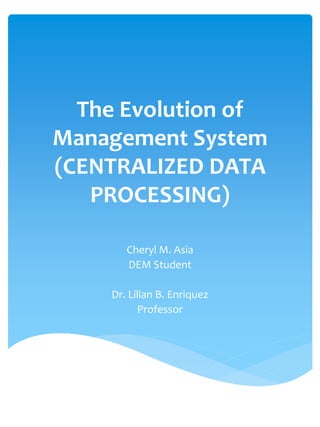
The evolution of management information system
- 1. The Evolution of Management System (CENTRALIZED DATA PROCESSING) Cheryl M. Asia DEM Student Dr. Lilian B. Enriquez Professor
- 2. Data - as a general concept refers to the fact that some existing information or knowledge is represented or coded in some form suitable for better usage or processing. Information -knowledge obtained from investigation, study, or instruction. System- a set of principles or procedures according to which something is done. Information System- is the information and communication technology (ICT) that an organization uses. MANAGEMENT INFORMATION SYSTEM (MIS) -a computerized information-processing system designed to support the activities of organizational management. MIS ( Management Information System)
- 3. A. Origin of Management Information Systems- industrial exhibition of Paris in 1801. Joseph Marie Charles Jacquard introduced the world to punch cards. B. The Creation of Punch Card Systems looms were hand-operated and if you wanted to create a complex pattern in cloth, you had to know – and remember – the order that different color threads were to be weaved into the fabric. C. Evolution of Punch Cards - By 1911, IBM emerged, then called the Computing-Tabulating-Recording Company. By this time, punch cards were used for recording and storing all sorts of information MIS BACKGROUND
- 4. D. The Emergence of MIS in Computers -computers began to emerge in the 1940s and 1950s, punch cards 1970’s were replaced by magnetic storage media like tapes and disks. E. MIS Developing Beyond Accounting- From the 1970s to the early 1990s, as computers became smaller, faster and more affordable, MIS developed beyond accounting to other business areas, like inventory systems, sales, marketing, manufacturing processes and engineering. MIS BACKGROUND
- 5. First Era (mid-1960s to mid-1970s) During the first years of computerized MIS, information systems were centralized and concerned solely with governance and the needs of management. Most information systems and their reports were under the control of accounting departments. Technology included third- generation mainframe computers, like the IBM 360. Languages included Assembler, Fortran, COBO and, Database e. Ethernet networks were developed during this time. EVOLUTION OF MIS THE FIVE ERAS OF MIS
- 6. Second Era (mid-1970s to mid- 1980s) While MIS was still mainly concerned with governance and the needs of management, more departments were beginning to benefit from the technology. In many companies, steering committees and user-led initiatives determined the shape and scope of additional IS projects. Technology included the first personal computers (PCs), minicomputers and mid- range computers. EVOLUTION OF MIS THE FIVE ERAS OF MIS
- 7. Third Era (mid-1980s to late 1990s) During the third era, centralized information systems began to spread out and information became decentralized. Each department had its own computer system. Managing information was often referred to as "herding cats." It was during this era that a new position emerged in many companies to oversee the acquisition and management of multiple information systems: the Chief Information Officer, or CIO. Technology during this era included internetworking and the beginning of the internet. EVOLUTION OF MIS THE FIVE ERAS OF MIS
- 8. Fourth Era (late 1990s to today) During the current era, information systems are still tightly tied to governance and management, however the systems are widely distributed, within the reach of nearly every employee who needs it across multiple platforms. Many information systems are integrated between different companies, so that a client business can readily access supplier information and their customers, in turn, can access that information. Technology now includes social media, search engines and ubiquitous computing through a variety of platforms including laptops, tablets and smartphones. EVOLUTION OF MIS THE FIVE ERAS OF MIS
- 9. Fifth Era (today forward) The increase in internet bandwidth over recent years has led to a substantial reliance on cloud computing. As a result, some maintain that this marks a new era in worker's ascendancy and that we are now in a fifth era for management information systems. Today, practically any employee is now in a position to make informed decisions with tools that are readily available across multiple platforms. Furthermore, the line between who produces and who consumes MIS information is increasingly blurred. EVOLUTION OF MIS THE FIVE ERAS OF MIS
- 10. When computers began to emerge in the 1940’s and 1950’s, punch cards were still a big part of information systems. They continued to play a role until the 1970’s when they were replaced by magnetic storage media like tapes and disks. These storage devices greatly increased the speed of calculating data Consequently, MIS began to develop for accounting. Calculating data and compiling it into reports could now be done in a fraction of the time it would have taken before. Centralized Data Processing was characterized by batch processing- that is transactions were stored and process all at one time, this limited any MIS usage. CENTRALIZED DATA PROCESSING
